A Short Review of Advances in MOF Glass Membranes for Gas Adsorption and Separation
Abstract
1. Introduction
2. Crystalline MOF Melting Mechanism
3. MOFs for Glass Formation
4. Categories of MOF Glass
4.1. Pure MOF Glasses
4.2. Blended MOF Glasses
4.3. MOF Crystal-Glass Composites (MOF-CGCs)
4.4. Flux Melted Glass
5. Structure and Properties of MOF Glass and Composite Membranes
6. Gas Adsorption Performance of MOF Glass Membranes
7. Gas Separation Performance of MOF Glass Membranes
8. Summary and Outlook
9. Materials and Methods
Author Contributions
Funding
Data Availability Statement
Acknowledgments
Conflicts of Interest
References
- Furukawa, H.; Cordova, K.E.; O’Keeffe, M.; Yaghi, O.M. The chemistry and applications of metal-organic frameworks. Science 2013, 341, 1230444. [Google Scholar] [CrossRef] [PubMed]
- Tuffnell, J.M.; Ashling, C.W.; Hou, J.; Li, S.; Longley, L.; Gómez, M.L.; Bennett, T.D. Novel metal–organic framework materials: Blends, liquids, glasses, and crystal–glass composites. Chem. Commun. 2019, 55, 8705–8715. [Google Scholar] [CrossRef] [PubMed]
- Yin, Z.; Zhang, Y.-B.; Yu, H.B.; Zeng, M.-H. How to create MOF glasses and take advantage of emerging opportunities. Sci. Bull. 2020, 65, 1432–1435. [Google Scholar] [CrossRef] [PubMed]
- Tao, H.; Bennett, T.D.; Yue, Y.J. Melt-quenched hybrid glasses from metal–organic frameworks. Adv. Mater. 2017, 29, 1601705. [Google Scholar] [CrossRef] [PubMed]
- Bennett, T.D.; Goodwin, A.L.; Dove, M.T.; Keen, D.A.; Tucker, M.G.; Barney, E.R.; Soper, A.K.; Bithell, E.G.; Tan, J.-C.; Cheetham, A.K. Structure and properties of an amorphous metal-organic framework. Phys. Rev. Lett. 2010, 104, 115503. [Google Scholar] [CrossRef] [PubMed]
- Bennett, T.D.; Yue, Y.; Li, P.; Qiao, A.; Tao, H.; Greaves, N.G.; Richards, T.; Lampronti, G.I.; Redfern, S.A.; Blanc, F.; et al. Melt-quenched glasses of metal–organic frameworks. J. Am. Chem. Soc. 2016, 138, 3484–3492. [Google Scholar] [CrossRef] [PubMed]
- Bennett, T.D.; Tan, J.-C.; Yue, Y.; Baxter, E.; Ducati, C.; Terrill, N.J.; Yeung, H.H.-M.; Zhou, Z.; Chen, W.; Henke, S.; et al. Hybrid glasses from strong and fragile metal-organic framework liquids. Nat. Commun. 2015, 6, 8079. [Google Scholar] [CrossRef] [PubMed]
- Yin, Z.; Zhao, Y.; Zeng, M.-H. Challenge, Advance and Emerging Opportunities for Metal-Organic Framework Glasses: From Dynamic Chemistry to Material Science and Noncrystalline Physics. Acta Chim. Sin. 2023, 81, 246. [Google Scholar] [CrossRef]
- Qiao, A.; Bennett, T.D.; Tao, H.; Krajnc, A.; Mali, G.; Doherty, C.M.; Thornton, A.W.; Mauro, J.C.; Greaves, G.N.; Yue, Y. A metal-organic framework with ultrahigh glass-forming ability. Sci. Adv. 2018, 4, 6827. [Google Scholar] [CrossRef]
- Zheng, Q.; Zhang, Y.; Montazerian, M.; Gulbiten, O.; Mauro, J.C.; Zanotto, E.D.; Yue, Y. Understanding glass through differential scanning calorimetry. Chem. Rev. 2019, 119, 7848–7939. [Google Scholar] [CrossRef]
- Madsen, R.S.; Qiao, A.; Sen, J.; Hung, I.; Chen, K.; Gan, Z.; Sen, S.; Yue, Y. Ultrahigh-field 67Zn NMR reveals short-range disorder in zeolitic imidazolate framework glasses. Science 2020, 367, 1473–1476. [Google Scholar] [CrossRef] [PubMed]
- Yan, J.; Gao, C.; Qi, S.; Jiang, Z.; Jensen, L.R.; Zhan, H.; Zhang, Y.; Yue, Y. Encapsulation of nano-Si into MOF glass to enhance lithium-ion battery anode performances. Nano Energy 2022, 103, 107779. [Google Scholar] [CrossRef]
- Gao, C.; Jiang, Z.; Qi, S.; Wang, P.; Jensen, L.R.; Johansen, M.; Christensen, C.K.; Zhang, Y.; Ravnsbæk, D.B.; Yue, Y. Metal-organic framework glass anode with an exceptional cycling-induced capacity enhancement for lithium-ion batteries. Adv. Mater. 2022, 34, 2110048. [Google Scholar] [CrossRef] [PubMed]
- Gaillac, R.; Pullumbi, P.; Beyer, K.; Chapman, K.W.; Keen, D.A.; Bennett, T.D.; Coudert, F.-X. Liquid metal–organic frameworks. Nat. Mater. 2017, 16, 1149–1154. [Google Scholar] [CrossRef] [PubMed]
- Ma, N.; Horike, S. Metal–organic network-forming glasses. Chem. Rev. 2022, 122, 4163–4203. [Google Scholar] [CrossRef]
- Das, C.; Ogawa, T.; Horike, S. Stable melt formation of 2D nitrile-based coordination polymer and hierarchical crystal–glass structuring. Chem. Commun. 2020, 56, 8980–8983. [Google Scholar] [CrossRef]
- Feng, Y.; Yan, W.; Kang, Z.; Zou, X.; Fan, W.; Jiang, Y.; Fan, L.; Wang, R.; Sun, D. Thermal treatment optimization of porous MOF glass and polymer for improving gas permeability and selectivity of mixed matrix membranes. Chem. Eng. J. 2023, 465, 142873. [Google Scholar] [CrossRef]
- Hou, J.; Chen, P.; Shukla, A.; Krajnc, A.; Wang, T.; Li, X.; Doasa, R.; Tizei, L.H.; Chan, B.; Johnstone, D.N.; et al. Liquid-phase sintering of lead halide perovskites and metal-organic framework glasses. Science 2021, 374, 621–625. [Google Scholar] [CrossRef]
- Ali, M.A.; Liu, X.; Sun, H.-T.; Ren, J.; Qiu, J. Metal inorganic–organic complex glass and fiber for photonic applications. Chem. Mater. 2022, 34, 2476–2483. [Google Scholar] [CrossRef]
- Lin, R.; Yao, Y.; Zulkifli, M.Y.B.; Li, X.; Gao, S.; Huang, W.; Smart, S.; Lyu, M.; Wang, L.; Chen, V.; et al. Binder-free mechanochemical metal–organic framework nanocrystal coatings. Nanoscale 2022, 14, 2221–2229. [Google Scholar] [CrossRef]
- Chen, W.; Horike, S.; Umeyama, D.; Ogiwara, N.; Itakura, T.; Tassel, C.; Goto, Y.; Kageyama, H.; Kitagawa, S. Glass formation of a coordination polymer crystal for enhanced proton conductivity and material flexibility. Angew. Chem. Int. Edit. 2016, 128, 5281–5286. [Google Scholar] [CrossRef]
- Minami, T. Fast ion conducting glasses. Non-Cryst. Solids 1985, 73, 273–284. [Google Scholar] [CrossRef]
- Ali, M.A.; Liu, X.; Li, Y.; Ren, J.; Qiu, J. Nonlinear-optical response in zeolitic imidazolate framework glass. Inorg. Chem. 2020, 59, 8380–8386. [Google Scholar] [CrossRef] [PubMed]
- Williams, J. Monsanto unveils new separation technology. Chem. Eng. News 1979, 47, 6–7. [Google Scholar]
- Horike, S.; Kitagawa, S. Unveiling liquid MOFs. Nat. Mater. 2017, 16, 1054–1055. [Google Scholar] [CrossRef] [PubMed]
- Tournier, R.F. Lindemann’s rule applied to the melting of crystals and ultra-stable glasses. Chem. Phys. Lett. 2016, 651, 198–202. [Google Scholar] [CrossRef][Green Version]
- Bennett, T.D.; Horike, S. Liquid, glass and amorphous solid states of coordination polymers and metal–organic frameworks. Nat. Rev. Mater. 2018, 3, 431–440. [Google Scholar] [CrossRef]
- Frentzel-Beyme, L.; Kloß, M.; Kolodzeiski, P.; Pallach, R.; Henke, S. Meltable mixed-linker zeolitic imidazolate frameworks and their microporous glasses: From melting point engineering to selective hydrocarbon sorption. J. Am. Chem. Soc. 2019, 141, 12362–12371. [Google Scholar] [CrossRef] [PubMed]
- Li, J.; Wang, J.; Li, Q.; Zhang, M.; Li, J.; Sun, C.; Yuan, S.; Feng, X.; Wang, B. Coordination Polymer Glasses with Lava and Healing Ability for High-Performance Gas Sieving. Angew. Chem. Int. Edit. 2021, 133, 21474–21479. [Google Scholar] [CrossRef]
- Hou, J.; Ashling, C.W.; Collins, S.M.; Krajnc, A.; Zhou, C.; Longley, L.; Johnstone, D.N.; Chater, P.A.; Li, S.; Coulet, M.-V.; et al. Metal-organic framework crystal-glass composites. Nat. Commun. 2019, 10, 2580. [Google Scholar] [CrossRef]
- Bumstead, A.M.; Pakamorė, I.; Richards, K.D.; Thorne, M.F.; Boyadjieva, S.S.; Castillo-Blas, C.; McHugh, L.N.; Sapnik, A.F.; Keeble, D.S.; Keen, D.A.; et al. Post-synthetic modification of a metal–organic framework glass. Chem. Mater. 2022, 34, 2187–2196. [Google Scholar] [CrossRef]
- Umeyama, D.; Horike, S.; Inukai, M.; Itakura, T.; Kitagawa, S. Inherent proton conduction in a 2D coordination framework. J. Am. Chem. Soc. 2012, 134, 12780–12785. [Google Scholar] [CrossRef]
- Hou, J.; Rios-Gomez, M.L.; Krajnc, A.; McCaul, A.; Li, S.; Bumstead, A.M.; Sapnik, A.F.; Deng, Z.; Lin, R.; Chater, P.A.; et al. Halogenated metal–organic framework glasses and liquids. J. Am. Chem. Soc. 2020, 142, 3880–3890. [Google Scholar] [CrossRef]
- Longley, L.; Collins, S.M.; Zhou, C.; Smales, G.J.; Norman, S.E.; Brownbill, N.J.; Ashling, C.W.; Chater, P.A.; Tovey, R.; Schönlieb, C.-B.; et al. Liquid phase blending of metal-organic frameworks. Nat. Commun. 2018, 9, 2135. [Google Scholar] [CrossRef]
- Ashling, C.W.; Johnstone, D.N.; Widmer, R.N.; Hou, J.; Collins, S.M.; Sapnil, A.F.; Bumstead, A.M.; Midgley, P.A.; Chater, P.A.; Keen, D.A.; et al. Synthesis and Properties of a Compositional Series of MIL-53(Al) Metal–Organic Framework Crystal-Glass Composites. J. Am. Chem. Soc. 2019, 141, 15641–15648. [Google Scholar] [CrossRef]
- Ao, D.; Yang, Z.; Qiao, Z.; Sun, Y.; Zhang, Z.; Guiver, M.D.; Zhong, C. Metal–Organic Framework Crystal–Glass Composite Membranes with Preferential Permeation of Ethane. Angew. Chem. Int. Edit. 2023, 135, e202304535. [Google Scholar] [CrossRef]
- Longley, L.; Collins, S.M.; Li, S.; Smales, G.J.; Erucar, I.; Qiao, A.; Hou, J.; Doherty, C.M.; Thornton, A.W.; Hill, A.J.; et al. Flux melting of metal–organic frameworks. Chem. Sci. 2019, 10, 3592–3601. [Google Scholar] [CrossRef]
- Li, S.; Limbach, R.; Longley, L.; Shirzadi, A.A.; Walmsley, J.C.; Johnstone, D.N.; Midgley, P.A.; Wondraczek, L.; Bennett, T.D. Mechanical properties and processing techniques of bulk metal–organic framework glasses. J. Am. Chem. Soc. 2018, 141, 1027–1034. [Google Scholar] [CrossRef]
- To, T.; Sørensen, S.S.; Stepniewska, M.; Qiao, A.; Jensen, L.R.; Bauchy, M.; Yue, Y.; Smedskjaer, M.M. Fracture toughness of a metal–organic framework glass. Nat. Commun. 2020, 11, 2593. [Google Scholar] [CrossRef]
- Longley, L.; Calahoo, C.; Limbach, R.; Xia, Y.; Tuffnell, J.M.; Sapnik, A.F.; Thorne, M.F.; Keeble, D.S.; Keen, D.A.; Wondraczek, L.; et al. Metal-organic framework and inorganic glass composites. Nat. Commun. 2020, 11, 5800. [Google Scholar] [CrossRef]
- Louis, F.-B.; Marvin, K.; Roman, P.; Soma, S.; Henning, M.; Joachim, L.; Heiko, W.; Jörg, D.; Sebastian, H. Porous purple glass—A cobalt imidazolate glass with accessible porosity from a meltable cobalt imidazolate framework. J. Mater. Chem. A 2019, 7, 985–990. [Google Scholar]
- Zhou, C.; Longley, L.; Krajnc, A.; Smales, G.J.; Qiao, A.; Erucar, I.; Doherty, C.M.; Thornton, A.W.; Hill, A.J.; Ashling, C.W.; et al. Metal-organic framework glasses with permanent accessible porosity. Nat. Commun. 2018, 9, 5042. [Google Scholar] [CrossRef]
- Lin, R.; Li, X.; Krajnc, A.; Li, Z.; Li, M.; Wang, W.; Zhuang, L.; Smart, S.; Zhu, Z.; Appadoo, D.; et al. Mechanochemically synthesised flexible electrodes based on bimetallic metal–organic framework glasses for the oxygen evolution reaction. Angew. Chem. Int. Edit. 2022, 61, e202112880. [Google Scholar] [CrossRef]
- Ashling, C.W.; Macreadie, L.K.; Southern, T.J.; Zhang, Y.; McHugh, L.N.; Evans, R.C.; Kaskel, S.; Telfer, S.G.; Bennett, T.D. Guest size limitation in metal–organic framework crystal–glass composites. J. Mater. Chem. A 2021, 9, 8386–8393. [Google Scholar] [CrossRef]
- Kitagawa, S. Future Porous Materials. Acc. Chem. Res. 2017, 50, 514–516. [Google Scholar] [CrossRef]
- Widmer, R.N.; Lampronti, G.I.; Anzellini, S.; Gaillac, R.; Farsang, S.; Zhou, C.; Belenguer, A.M.; Wilson, C.W.; Palmer, H.; Kleppe, A.K.; et al. Pressure promoted low-temperature melting of metal–organic frameworks. Nat. Mater. 2019, 18, 370–376. [Google Scholar] [CrossRef]
- Wang, Y.; Jin, H.; Ma, Q.; Mo, K.; Mao, H.; Feldhoff, A.; Cao, X.; Li, Y.; Pan, F.; Jiang, Z. A MOF glass membrane for gas separation. Angew. Chem. Int. Edit. 2020, 132, 4395–4399. [Google Scholar] [CrossRef]
- Yang, Z.; Belmabkhout, Y.; McHugh, L.N.; Ao, D.; Sun, Y.; Li, S.; Qiao, Z.; Bennett, T.D.; Guiver, M.D.; Zhong, C. ZIF-62 glass foam self-supported membranes to address CH4/N2 separations. Nat. Mater. 2023, 22, 888–894. [Google Scholar] [CrossRef]
- Lin, R.; Hou, J.; Li, M.; Wang, Z.; Ge, L.; Li, S.; Smart, S.; Zhu, Z.; Bennett, T.D.; Chen, V. Interfacial engineering of a polymer–MOF composite by in situ vitrification. Chem. Commun. 2020, 56, 3609–3612. [Google Scholar] [CrossRef]
- Mubashir, M.; Dumée, L.F.; Fong, Y.Y.; Jusoh, N.; Lukose, J.; Chai, W.S.; Show, P.L. Cellulose acetate-based membranes by interfacial engineering and integration of ZIF-62 glass nanoparticles for CO2 separation. J. Hazard. 2021, 415, 125639. [Google Scholar] [CrossRef]
- Xia, H.; Jin, H.; Zhang, Y.; Song, H.; Hu, J.; Huang, Y.; Li, Y. A long-lasting TIF-4 MOF glass membrane for selective CO2 separation. J. Membr. Sci. 2022, 655, 120611. [Google Scholar] [CrossRef]
- Zhang, Y.; Wang, Y.; Xia, H.; Gao, P.; Cao, Y.; Jin, H.; Li, Y. A hybrid ZIF-8/ZIF-62 glass membrane for gas separation. Chem. Commun. 2022, 58, 9548–9551. [Google Scholar] [CrossRef]
- Li, D.; Yang, Z.; Yang, L.; Ma, C.; Ye, M.; Sun, Y.; Qiao, Z.; Chen, A. Self-supported flux melted glass membranes fabricated by melt quenching for gas separation. J. Membr. Sci. 2024, 695, 122492. [Google Scholar] [CrossRef]
- Ma, C.; Li, N.; Li, D.; Gu, Z.; Qiao, Z.; Zhong, C. A self-supported agZIF-UC-4 glass membrane for gas separation. J. Membr. Sci. 2023, 683, 121873. [Google Scholar] [CrossRef]
- Ao, D.; Yang, Z.; Chen, A.; Sun, Y.; Ye, M.; Tian, L.; Cen, X.; Xie, Z.; Du, J.; Qiao, Z.; et al. Effective C4 Separation by Zeolite Metal-Organic Framework Composite Membranes. Angew. Chem. Int. Edit. 2024. online ahead of print. [Google Scholar]

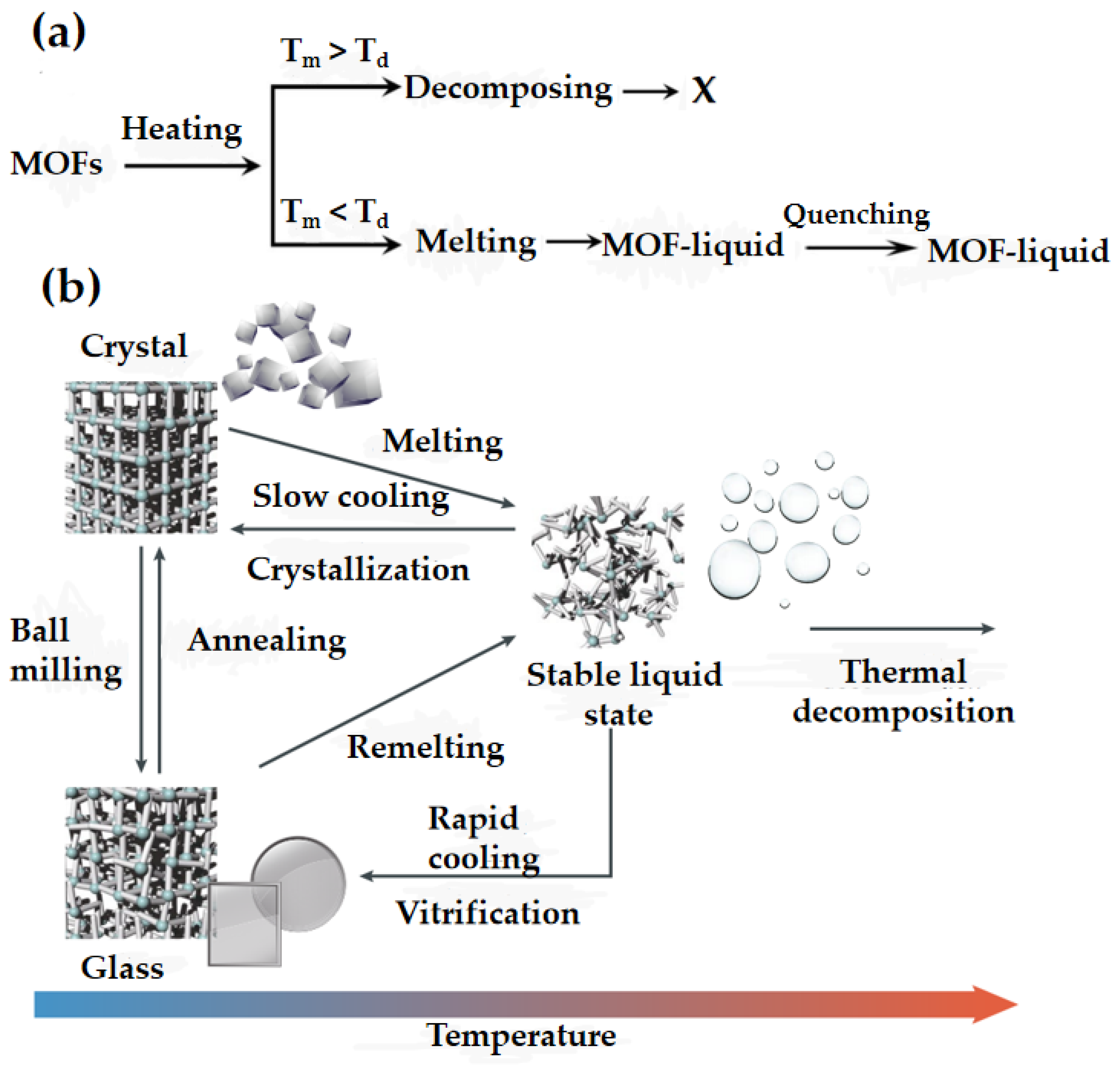

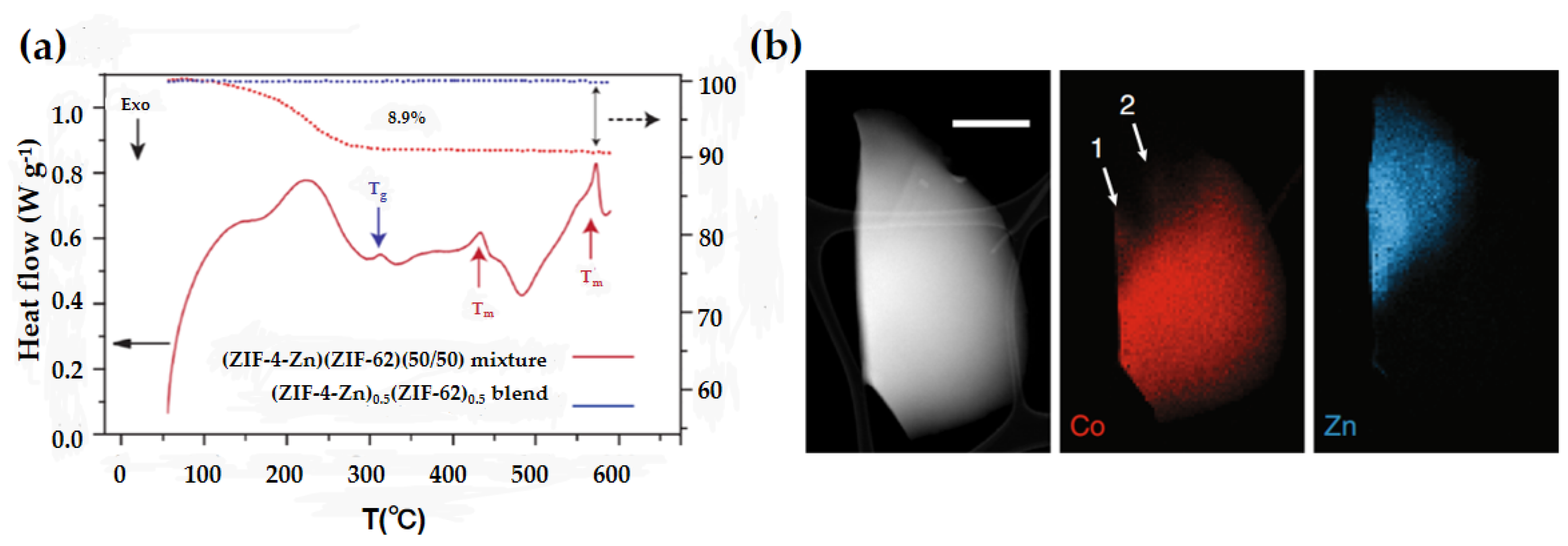
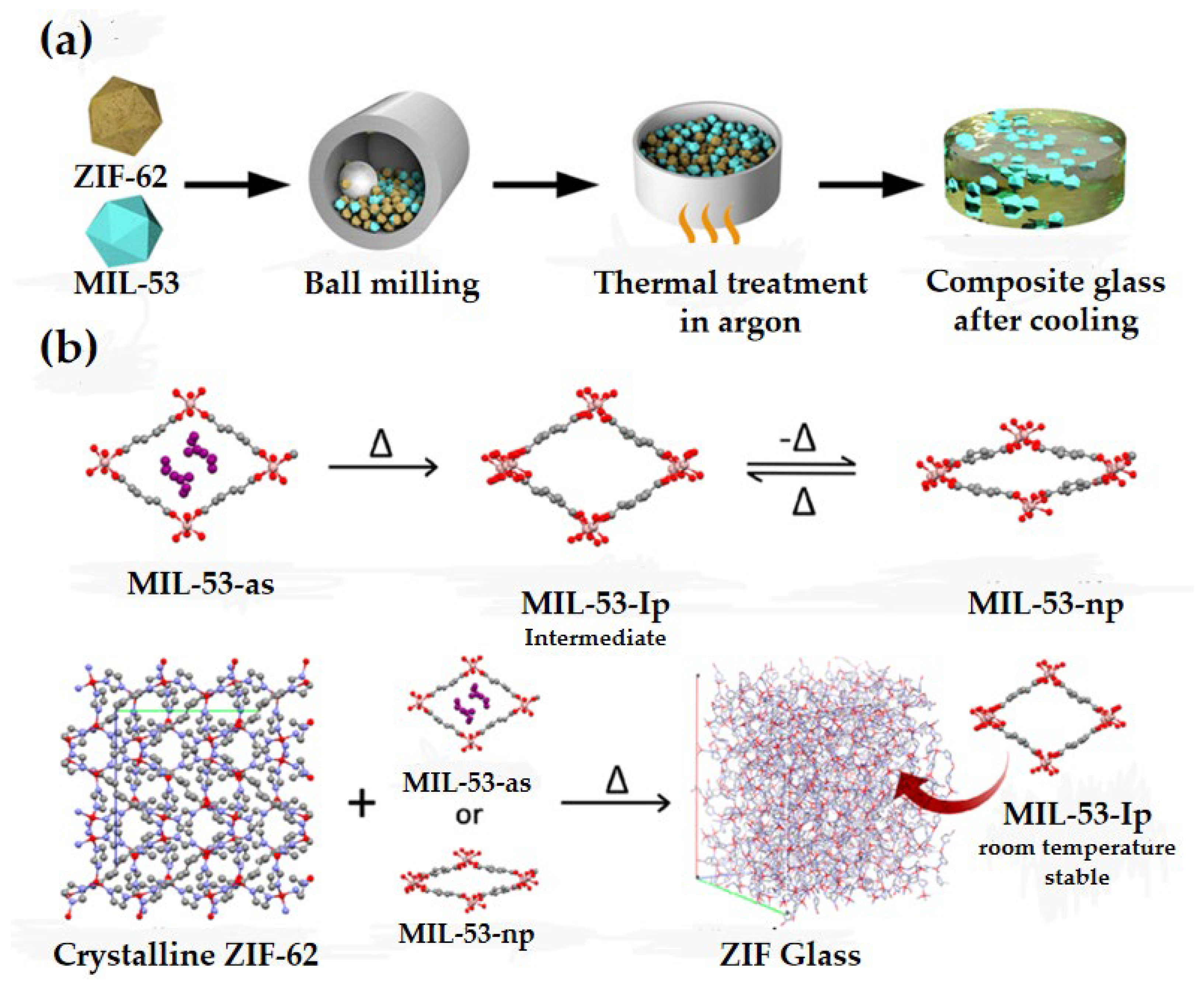

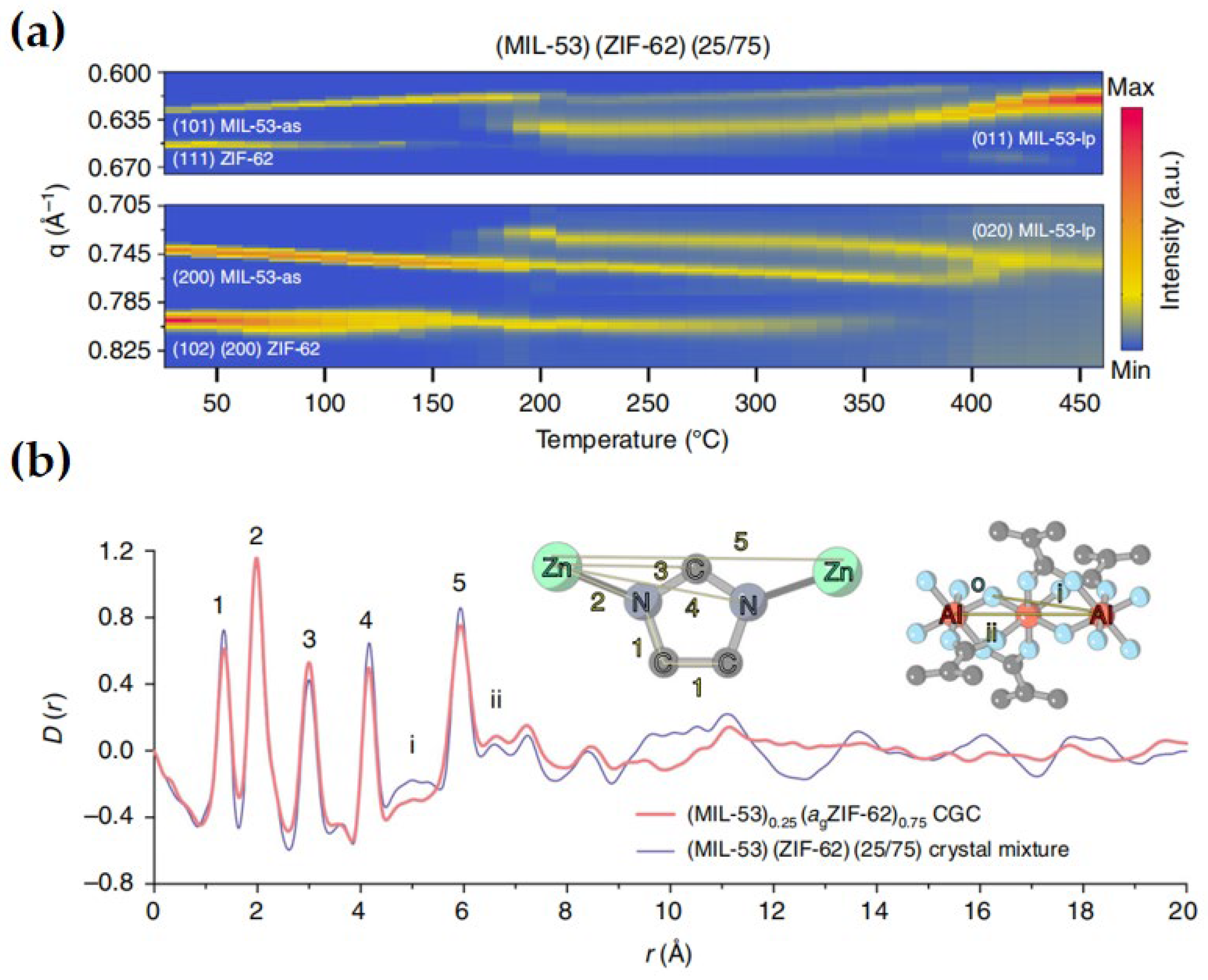
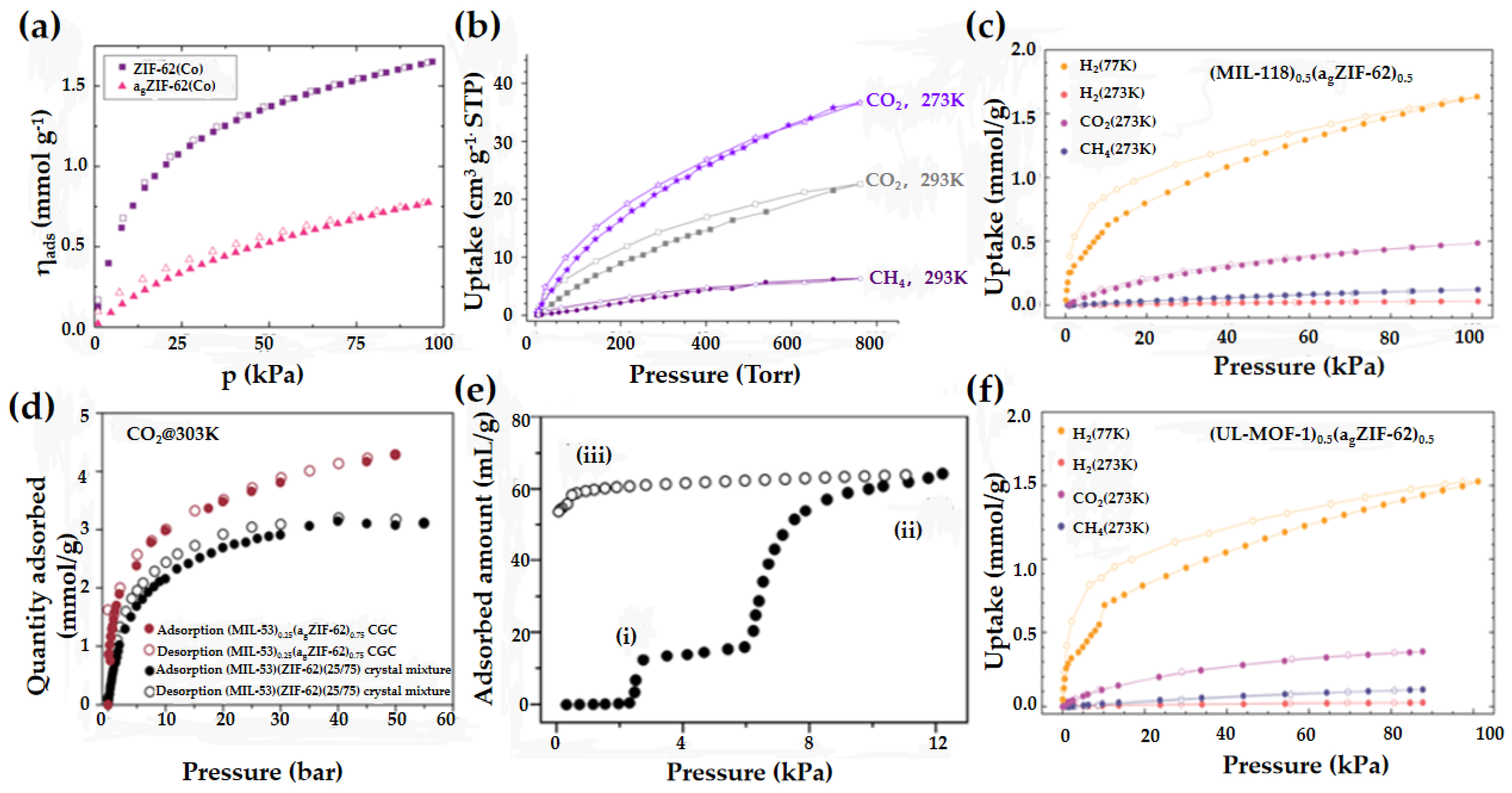

| MOF | Method | Permeance (GPU) | Selectivity | Ref. | ||||||||
|---|---|---|---|---|---|---|---|---|---|---|---|---|
| H2 | CO2 | CH4 | N2 | C2H6 | H2/CH4 | CO2/N2 | CO2/CH4 | CH4/N2 | C2H6/C2H4 | |||
| ZIF-62 glass | In situ | 65.67 | 28.95 | 1.10 | 1.22 | N/A | 50 | 34 | 36 | N/A | N/A | [47] |
| Zn-P-dmbim | Hot-casting | 6851.52 | 3805.01 | 1246.83 | 1406.74 | N/A | 5.5 | N/A | N/A | N/A | N/A | [29] |
| agfZIF-62 | Melt-quenching | N/A | N/A | 30,000 | N/A | N/A | N/A | N/A | N/A | 6 | N/A | [48] |
| ZIF-62 | Hot-casting | N/A | 579.82 | N/A | 26.51 | N/A | N/A | 21.9 | N/A | N/A | N/A | [49] |
| ZIF-62/ZIF-8 | Melt-quenching | N/A | N/A | N/A | N/A | 41,569 | N/A | N/A | N/A | N/A | 7.16 | [36] |
| ZIF-62 | Solvent-casting | N/A | 84.8 | N/A | N/A | N/A | N/A | N/A | 35.3 | N/A | N/A | [50] |
| TIF-4 | Melt-quenching | N/A | 149 | N/A | 0.549 | N/A | N/A | 27 | 30 | N/A | N/A | [51] |
| ZIF-8/ZIF-62 | Melt-quenching | N/A | 6.5 | N/A | N/A | N/A | N/A | 34.6 | 29.9 | N/A | N/A | [52] |
| ZIF-7/ZIF-62 | Melt-quenching | 120.3 | 43.1 | N/A | N/A | N/A | 98.6 | N/A | 35.3 | N/A | N/A | [53] |
| agZIF-UC-4 | Melt-quenching | N/A | 4752 | 818 | N/A | N/A | N/A | 36 | N/A | 6.2 | N/A | [54] |
| agZIF-62/PIM-1 | In situ | N/A | 5914 | N/A | N/A | N/A | N/A | N/A | 67 | N/A | N/A | [17] |
Disclaimer/Publisher’s Note: The statements, opinions and data contained in all publications are solely those of the individual author(s) and contributor(s) and not of MDPI and/or the editor(s). MDPI and/or the editor(s) disclaim responsibility for any injury to people or property resulting from any ideas, methods, instructions or products referred to in the content. |
© 2024 by the authors. Licensee MDPI, Basel, Switzerland. This article is an open access article distributed under the terms and conditions of the Creative Commons Attribution (CC BY) license (https://creativecommons.org/licenses/by/4.0/).
Share and Cite
Li, Z.; Wang, Y.; Zhang, J.; Cheng, S.; Sun, Y. A Short Review of Advances in MOF Glass Membranes for Gas Adsorption and Separation. Membranes 2024, 14, 99. https://doi.org/10.3390/membranes14050099
Li Z, Wang Y, Zhang J, Cheng S, Sun Y. A Short Review of Advances in MOF Glass Membranes for Gas Adsorption and Separation. Membranes. 2024; 14(5):99. https://doi.org/10.3390/membranes14050099
Chicago/Turabian StyleLi, Zichen, Yumei Wang, Jianxin Zhang, Shiqi Cheng, and Yue Sun. 2024. "A Short Review of Advances in MOF Glass Membranes for Gas Adsorption and Separation" Membranes 14, no. 5: 99. https://doi.org/10.3390/membranes14050099
APA StyleLi, Z., Wang, Y., Zhang, J., Cheng, S., & Sun, Y. (2024). A Short Review of Advances in MOF Glass Membranes for Gas Adsorption and Separation. Membranes, 14(5), 99. https://doi.org/10.3390/membranes14050099







